+ Open data
Open data
- Basic information
Basic information
| Entry | Database: PDB / ID: 4.0E+59 | ||||||
|---|---|---|---|---|---|---|---|
| Title | Crystal structure of GCCGCCGC duplex | ||||||
 Components Components | RNA duplex containing CCG repeats | ||||||
 Keywords Keywords | RNA / 3' slippery duplexes / X-linked mental retardation / Huntington's disease / myotonic dystrophy type 1 / CCG repeats | ||||||
| Function / homology | RNA Function and homology information Function and homology information | ||||||
| Biological species |  Homo sapiens (human) Homo sapiens (human) | ||||||
| Method |  X-RAY DIFFRACTION / X-RAY DIFFRACTION /  SYNCHROTRON / SYNCHROTRON /  MOLECULAR REPLACEMENT / Resolution: 1.54 Å MOLECULAR REPLACEMENT / Resolution: 1.54 Å | ||||||
 Authors Authors | Kiliszek, A. / Kierzek, R. / Krzyzosiak, W.J. / Rypniewski, W. | ||||||
 Citation Citation |  Journal: Nucleic Acids Res. / Year: 2012 Journal: Nucleic Acids Res. / Year: 2012Title: Crystallographic characterization of CCG repeats. Authors: Kiliszek, A. / Kierzek, R. / Krzyzosiak, W.J. / Rypniewski, W. | ||||||
| History |
|
- Structure visualization
Structure visualization
| Structure viewer | Molecule:  Molmil Molmil Jmol/JSmol Jmol/JSmol |
|---|
- Downloads & links
Downloads & links
- Download
Download
| PDBx/mmCIF format |  4e59.cif.gz 4e59.cif.gz | 15.9 KB | Display |  PDBx/mmCIF format PDBx/mmCIF format |
|---|---|---|---|---|
| PDB format |  pdb4e59.ent.gz pdb4e59.ent.gz | 10.6 KB | Display |  PDB format PDB format |
| PDBx/mmJSON format |  4e59.json.gz 4e59.json.gz | Tree view |  PDBx/mmJSON format PDBx/mmJSON format | |
| Others |  Other downloads Other downloads |
-Validation report
| Summary document |  4e59_validation.pdf.gz 4e59_validation.pdf.gz | 398.1 KB | Display |  wwPDB validaton report wwPDB validaton report |
|---|---|---|---|---|
| Full document |  4e59_full_validation.pdf.gz 4e59_full_validation.pdf.gz | 397.8 KB | Display | |
| Data in XML |  4e59_validation.xml.gz 4e59_validation.xml.gz | 2.8 KB | Display | |
| Data in CIF |  4e59_validation.cif.gz 4e59_validation.cif.gz | 3.2 KB | Display | |
| Arichive directory |  https://data.pdbj.org/pub/pdb/validation_reports/e5/4e59 https://data.pdbj.org/pub/pdb/validation_reports/e5/4e59 ftp://data.pdbj.org/pub/pdb/validation_reports/e5/4e59 ftp://data.pdbj.org/pub/pdb/validation_reports/e5/4e59 | HTTPS FTP |
-Related structure data
| Related structure data | 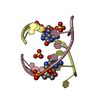 4e58SC S: Starting model for refinement C: citing same article ( |
|---|---|
| Similar structure data |
- Links
Links
- Assembly
Assembly
| Deposited unit | 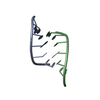
| |||||||||||||||
|---|---|---|---|---|---|---|---|---|---|---|---|---|---|---|---|---|
| 1 |
| |||||||||||||||
| 2 | 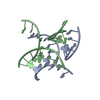
| |||||||||||||||
| Unit cell |
| |||||||||||||||
| Components on special symmetry positions |
|
- Components
Components
| #1: RNA chain | Mass: 2516.569 Da / Num. of mol.: 2 / Source method: obtained synthetically / Details: This sequence is a part of mRNA in humans / Source: (synth.)  Homo sapiens (human) Homo sapiens (human)#2: Water | ChemComp-HOH / | |
|---|
-Experimental details
-Experiment
| Experiment | Method:  X-RAY DIFFRACTION / Number of used crystals: 1 X-RAY DIFFRACTION / Number of used crystals: 1 |
|---|
- Sample preparation
Sample preparation
| Crystal | Density Matthews: 1.77 Å3/Da / Density % sol: 30.41 % |
|---|---|
| Crystal grow | Temperature: 303 K / Method: vapor diffusion, hanging drop / pH: 5.6 Details: magnesium acetate, MES and ammonium sulphate, pH 5.6, VAPOR DIFFUSION, HANGING DROP, temperature 303K |
-Data collection
| Diffraction | Mean temperature: 100 K |
|---|---|
| Diffraction source | Source:  SYNCHROTRON / Site: SYNCHROTRON / Site:  BESSY BESSY  / Beamline: 14.2 / Wavelength: 0.9184 Å / Beamline: 14.2 / Wavelength: 0.9184 Å |
| Detector | Type: MARMOSAIC 225 mm CCD / Detector: CCD / Date: Oct 5, 2010 |
| Radiation | Monochromator: Si / Protocol: SINGLE WAVELENGTH / Monochromatic (M) / Laue (L): M / Scattering type: x-ray |
| Radiation wavelength | Wavelength: 0.9184 Å / Relative weight: 1 |
| Reflection | Resolution: 1.54→20 Å / Num. all: 5101 / Num. obs: 5101 / % possible obs: 99.9 % / Observed criterion σ(F): 0 / Observed criterion σ(I): 0 / Redundancy: 4.3 % / Rsym value: 0.04 / Net I/σ(I): 26.14 |
| Reflection shell | Resolution: 1.54→1.57 Å / Redundancy: 3.8 % / Mean I/σ(I) obs: 2.06 / Num. unique all: 262 / Rsym value: 0.711 / % possible all: 100 |
- Processing
Processing
| Software |
| |||||||||||||||||||||||||
|---|---|---|---|---|---|---|---|---|---|---|---|---|---|---|---|---|---|---|---|---|---|---|---|---|---|---|
| Refinement | Method to determine structure:  MOLECULAR REPLACEMENT / Starting model: 4.0E+58 / Resolution: 1.54→18.715 Å / SU ML: 0.25 / Cross valid method: THROUGHOUT / σ(F): 1.99 / Phase error: 30.22 / Stereochemistry target values: ML MOLECULAR REPLACEMENT / Starting model: 4.0E+58 / Resolution: 1.54→18.715 Å / SU ML: 0.25 / Cross valid method: THROUGHOUT / σ(F): 1.99 / Phase error: 30.22 / Stereochemistry target values: ML
| |||||||||||||||||||||||||
| Solvent computation | Shrinkage radii: 0.16 Å / VDW probe radii: 0.5 Å / Solvent model: FLAT BULK SOLVENT MODEL / Bsol: 63.918 Å2 / ksol: 0.458 e/Å3 | |||||||||||||||||||||||||
| Displacement parameters | Biso mean: 27.79 Å2
| |||||||||||||||||||||||||
| Refinement step | Cycle: LAST / Resolution: 1.54→18.715 Å
| |||||||||||||||||||||||||
| Refine LS restraints |
| |||||||||||||||||||||||||
| LS refinement shell | Resolution: 1.54→1.695 Å
|
 Movie
Movie Controller
Controller



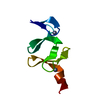
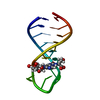
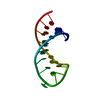

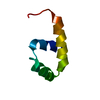

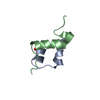

 PDBj
PDBj
